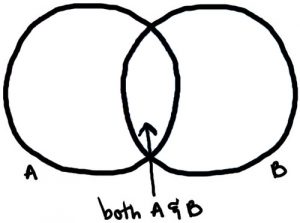SURPRISE!
You have to write another essay.
You were hoping for a surprise party, weren’t you? Sorry, I can’t help you there. But if you think writing a comparative essay is one heck of a good time, then this party is for you!
Okay, the fact that you have to write another essay isn’t really that much of a surprise, but what can be a not-so-happy surprise is seeing a D+ on a paper when you thought you earned at least a B.
So let’s skip the nasty surprise of a bad essay grade and move on to something more positive: how to write a good comparative essay.
Let’s Get This Party Started: How to Write a Surprisingly Good Comparative Essay

Writing a comparative essay is like planning a party in the sense that you absolutely must have a plan.
You can’t just tell people to come over for a graduation party without creating a guest list, sending out invites, buying food and drinks, setting up the space, and perhaps organizing activities.
You can’t simply start writing a comparative essay without deciding your topics, determining points of comparison and contrast, and choosing examples to support your comparisons.
So let’s start our essay-writing party by doing some planning of our own.
Here’s a five-step plan you’ll need in order to write a surprisingly good comparative essay (also known as a compare and contrast essay).
Step 1: Choose appropriate topics
If you’re supposed to write about war and you write about peace, this certainly isn’t an appropriate topic for your assignment.
But choosing the right topic goes beyond just meeting assignment guidelines for acceptable topics. You need to find subjects that you can compare and contrast.
If you choose to compare a frat party to your grandmother’s 85th birthday celebration at the senior living center, chances are you won’t find a lot of similarities. (Unless, of course, grandma is still a party animal!)
At any rate, you’ll need to choose subjects that have something in common, like a graduation party and a retirement party. While there are clear differences in the age of the person being honored, both parties celebrate accomplishments and mark a new stage in a person’s life.
Remember, you’re writing a comparative essay. Without a solid list of similarities and differences, you don’t have a strong essay.
Stumped for topics? Check out these 49 Compare and Contrast Essay Topics to Help Get You Started, or browse some example compare and contrast essays for inspiration.
Step 2: Prewrite
Once the subjects of your paper are in place, prewrite to sort out the ideas you’ll compare and contrast. If you’re not sure which form of prewriting to try, consider listing or using a Venn diagram.
Listing is just like it sounds. Make a list of similarities. Then make a list of differences.
If you’re more visual, try a Venn diagram. Draw intersecting circles then fill in the circles with similarities and differences.
Circles A and B will contain information applicable to only those subjects. (These are the differences.) The point at which the circles intersect will contain similarities between the two subjects.
Here’s a basic example of a Venn diagram to help you see what I mean.

Step 3: Organize and narrow ideas
Whether you’re comparing a tea party to a dinner party, the Democratic Party to the Republican Party, or the Labour Party to the Monster Raving Loony Party (it’s an actual political party—look it up), chances are, you’ll have long lists or a very full Venn diagram with all sorts of information.
You can’t (and shouldn’t) try to fit all of your ideas into your paper. Look for a few important points of comparison.
Here’s what I mean.
Let’s say you’re comparing a high school graduation party to a retirement party. What do the two parties have in common? How are they different?
You might start your lists with these ideas:
Similarities
- Guests are friends and family.
- Food/drinks are provided.
- Lots of socializing at the party.
- Gifts are given to the honored guest.
- Party signifies a new chapter in life.
Differences
- Spouse or children might throw a retirement party. Parents usually host a graduation party.
- Alcohol might be served at a retirement party, but 18 year olds can’t legally drink alcohol at their own graduation parties.
- Retirement party might be a surprise. Graduation parties usually aren’t surprise parties.
After you’ve created a detailed list of similarities and differences, start to narrow your focus and decide which points will be most important to include in your essay.
It’s pretty obvious that any party will have guests, and most graduation and retirement parties serve food and drinks. So writing about these as points of comparison doesn’t make for a very exciting paper.
On the other hand, pointing out that graduation and retirement parties are similar because they both signify a new chapter in a person’s life makes for a much more unique and surprisingly good essay.
This type of comparison moves beyond the obvious. It begins to develop a more critical analysis and is just the type of focus you can use to write an engaging paper.
Step 4: Draft
Now that the planning stages are behind you, it’s time to write your comparative essay.
It’s always a smart idea to sketch out a few basic points before you begin writing, so check out this resource to help you outline ideas.
When you start drafting your paper, keep these key points in mind.
Like most essays, a comparative essay needs an introduction (with a clear thesis statement), body paragraphs, and a conclusion. It also needs evidence to support your claims.
A comparative essay usually follows one of the following two patterns:
- The essay will explain all information about Subject A (a graduation party, for instance), then all information about Subject B (a retirement party, for instance).
- The essay will explain the information point by point, alternating information about Subject A with a comparable point about Subject B.
Choosing either pattern of organization is generally acceptable. Simply make sure you choose a clear pattern. Then stick with it throughout your entire paper.
The Party’s Over
At the end of every party is the task that no one wants to face: the cleanup.
After you’ve written your paper, you’ll also need to spend time on the cleanup. This is where revision comes into play.
Step 5: Revise
Resist the urge to turn in your draft as is. Trust me, it will still need some work. You’ll need to look for small things—such as spelling, grammar, and format—but you’ll also need to check for larger concerns, such as content and style.
This is where our expert cleaning crew comes in. Send your draft to our Kibin editors. They’re ready 24/7 to help clean up any draft.
Party on, and happy writing!

